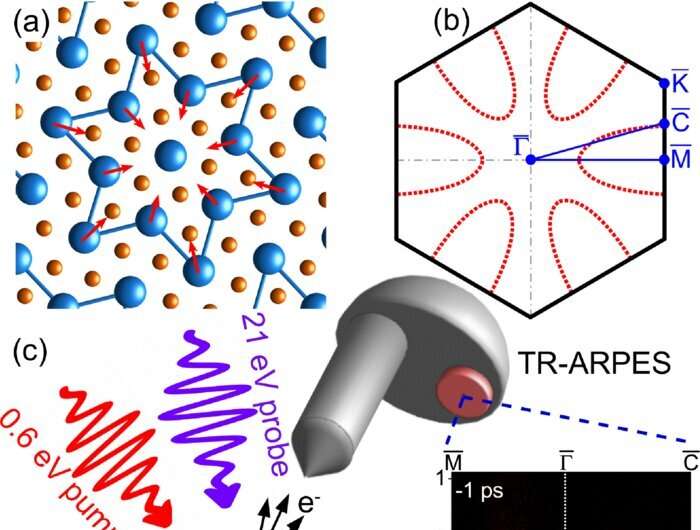(a) Pictorial view of the starlike lattice reconstruction in the CDW phase of 1T−TaSe2. (b) Surface-projected Brillouin zone (BZ) of the undistorted “normal” state. The red dashed lines mimic the Fermi surface and the blue solid line indicates the experimental path through the BZ as measured by TR-ARPES. (c) Sketch of the TR-ARPES experiment with laser photon energies. Credit: Physical Review Letters (2023). DOI: 10.1103/PhysRevLett.130.156401
The Science and Technology Facilities Council (STFC) Central Laser Facility (CLF) is celebrating the publication of the first paper from its newly upgraded Artemis lab space.
The study used short light pulses at Artemis' 1 kHz beamline to study the quantum material, tantalum diselenide (1T-TaSe2) to visualize the motion of electrons and ions inside materials in real-time, providing valuable insights into its complex behaviors.
The finding highlights the role of the crystal lattices in driving and stabilizing phase transitions in quantum materials. This understanding could lead to the design of materials with unique electronic properties and was made possible by the advanced capabilities of the Artemis lab space.
Artemis, which forms part of the Research Complex at Harwell (RCaH) at the STFC Harwell Campus in Oxfordshire, is a state-of-the-art facility dedicated to studying the ultrafast motion of electrons in molecules and novel materials. Opened in late 2021, it has yielded crucial insights into the behavior of charge-density-wave (CDW) transitions in quantum materials.
Quantum materials, which exhibit unique properties, have been a subject of intense research in condensed matter physics.
To understand the fundamental interactions that occur within these materials, the STFC Artemis lab space provides cutting-edge capabilities, including ultrafast laser sources, XUV beamlines, and end-stations for molecular dynamics, condensed matter physics, and imaging. The facility is one of few in the world capable of recording and capturing processes that happen at femtosecond timescales.
The results that Artemis can produce not only promote the development of innovative technologies, but also expand our fundamental understanding of the complicated physics found in the interactions between light and matter.
This latest research was led by Dr. Enrico Da Como from the University of Bath, in collaboration with Dr. Charles James Sayers from the Polytechnic University of Milan, and Dr. Ettore Carpene from the Institute of Photonics and Nanotechnologies of the Italian National Research Council (CNR).
The paper has been published by the Physical Review Letters.
Dr. Charles James Sayers, Research Fellow in the ultrafast spectroscopy group at Polytechnic University of Milan, says, "Using ultrashort pulses of light on the order of femtoseconds, such as those available at the Artemis facility, allows us to directly visualize the motion of electrons and ions inside materials in real time, providing a great insight into the important interactions occurring inside these exotic materials."
Dr. Ettore Carpene, Researcher at the Institute of Photonics and Nanotechnologies of the CNR, says, "One of the most important scientific questions surrounding quantum materials it the origin of phase transitions to ordered states of matter."
Dr. Carlotte Sanders, Senior Experimental Scientist at STFC Central Laser Facility, says, "We are incredibly happy to have the new Artemis lab up and running and producing papers. Not only are we enjoying the benefits of our new lab space, but with our new HiLUX upgrades of the next four years, our users can expect even more new capabilities in the near future. It is an extremely exciting time.
"It was great to work with colleagues at the University of Bath, Politecnico di Milano, and CNR-IFN on this interesting project. We look forward to a lot more top-notch science with them and the rest of our user community in the future."
More information: C. J. Sayers et al, Exploring the Charge Density Wave Phase of 1T−TaSe2 : Mott or Charge-Transfer Gap?, Physical Review Letters (2023). DOI: 10.1103/PhysRevLett.130.156401
Journal information: Physical Review Letters
Provided by UK Research and Innovation
























